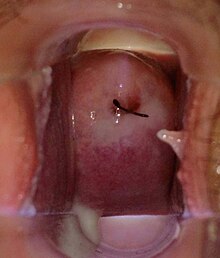
Back Ausfluss ALS إفراز مهبلي Arabic Вагинално течение Bulgarian যোনিস্রাব Bengali/Bangla Fluix vaginal Catalan Skedesekret Danish Scheidenausfluss German Secreción vaginal Spanish Bagina-fluxu Basque ترشحات واژن Persian
| Vaginal discharge | |
|---|---|
 | |
| Medical speculum exam shows normal vagina and cervix with normal milky white vaginal discharge on the vaginal walls, cervix, and pooled in the posterior vaginal fornix (IUD strings visible at opening of cervix) | |
| Specialty | Gynecology |
This article about biology may be excessively human-centric. (October 2024) |
Vaginal discharge is a mixture of liquid, cells, and bacteria that lubricate and protect the vagina.[1][2] This mixture is constantly produced by the cells of the vagina and cervix, and it exits the body through the vaginal opening. The composition, quality, and amount of discharge varies between individuals, and can vary throughout the menstrual cycle and throughout the stages of sexual and reproductive development.[3] Normal vaginal discharge may have a thin, watery consistency or a thick, sticky consistency, and it may be clear or white in color.[1][2] Normal vaginal discharge may be large in volume but typically does not have a strong odor, nor is it typically associated with itching or pain.[3]
While most discharge is considered physiologic (represents normal functioning of the body), some changes in discharge can reflect infection or other pathological processes.[4][5] Infections that may cause changes in vaginal discharge include vaginal yeast infections, bacterial vaginosis, and sexually transmitted infections.[6][2] The characteristics of abnormal vaginal discharge vary depending on the cause, but common features include a change in color, a foul odor, and associated symptoms such as itching, burning, pelvic pain, or pain during sexual intercourse.[7]
- ^ a b Beckmann, R.B. (2014). Obstetrics and Gynecology (7th ed.). Baltimore, MD: Lippincott Williams & Wilkins. p. 260. ISBN 9781451144314.
- ^ a b c "Vaginal discharge color guide: Causes and when to see a doctor". www.medicalnewstoday.com. 2020-01-10. Retrieved 2022-04-25.
- ^ a b Hacker, Neville F. (2016). Hacker & Moore's Essentials of Obstetrics and Gynecology (6th ed.). Philadelphia, PA: Elsevier. p. 276. ISBN 9781455775583.
- ^ Lentz, Gretchen M. (2012). Comprehensive Gynecology (6th ed.). Philadelphia, PA: Elsevier. pp. 532–533. ISBN 9780323069861.
- ^ LeBlond, Richard F. (2015). "Chapter 11". DeGowin's Diagnostic Examination (10th ed.). McGraw-Hill Education. ISBN 9780071814478.
- ^ Cite error: The named reference
:15was invoked but never defined (see the help page). - ^ Cite error: The named reference
:9was invoked but never defined (see the help page).